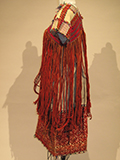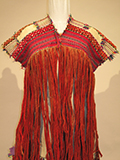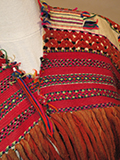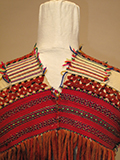The NowesArk Collection at UNC-Chapel Hill contains a Burmese dress. When it was donated, it included a handwritten tag reading "Burma/Thailand Saymoewah Dress for single girls to wear at home, Kenkat." Dresses like this are traditionally worn by the Karen peoples in the Karen State in Myanmar. The garment is hand woven and colorful. Your eyes are dawn to the red/orange color of the garment; ther colors present include green, orange, purple, pink, yellow, black, blue, and white.
The overall length of the saymoewah is forty inches. It is divided into three sections: The first is the shoulders that end right above the breastbone, which is seven inches long. Then, white sack-like material (loosely woven cotton canvas) starts at the breastbone and is nineteen-and-a half inches long, reaching almost to the knees. Attached to this middle piece of the garment are cords, which on average are about twenty-two inches long. The cords dominate the dress with close to one hundred pieces on the garment. The bottom section of the Burmese dress is thirteen inches long.
The dress has four pieces of a cotton canvas base that are sewn together to make a symmetrical dress. The width is thirty-seven inches around making it appropriate for a child or teenage girl given the size. The dress has been enhanced by the addition of colored threads. Burmese women learn to sew and embroider at a young age beginning with quilts and dresses. Two types of stitching are apparent. One is inserting colored threads into the loosely woven canvas and the second if using a couch stitch. Couching involves placing threads or yarn over the fabric and stab stitching it into place to make beautiful designs. One is able to see this clearly in the shoulders and at the bottom of the dress, as can be seen in Figures 1 and 2 below.
To add even more interest to the dress, some of the threads have been cut after putting them into place, creating a fuzzy effect (like chenille) and the ends have been left exposed adding texture. Beads and pom-poms have also been stitched into place.
Figure 1: Shoulder Detail |
Figure 2: Front Detail |
 |
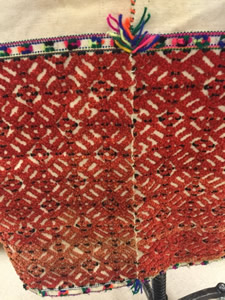 |
The function of the cords, which look like long heavy fringe, can mean multiple things to different Karen people. Most sources suggest that they provide a connection to their heritage. Others suggest that they indicate a commitment to purity before marriage as indicated by their use only on dresses worn by unmarried females. The dress of married Karen women lacks cords.
Figure 3: Detail of Cords |
Figure 4: Detail of Dress under Cords |
 |
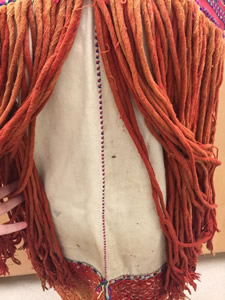 |
The garment is not only beautiful and colorful it is symbollic. Saymoewah vary in designs but the colors and cords remain the same in most.
© Lauren McNeill Smith, Class of 2016
Drama 475.001, Spring 2016 Semester
University of North Carolina at Chapel Hill


